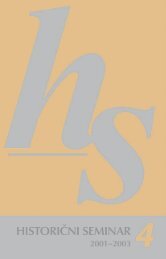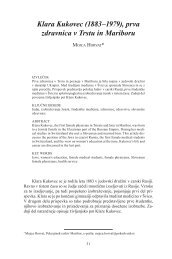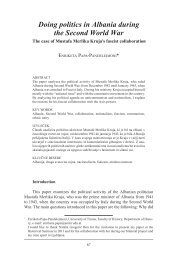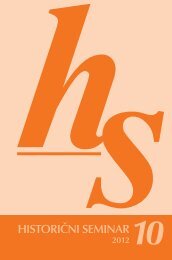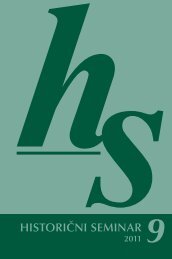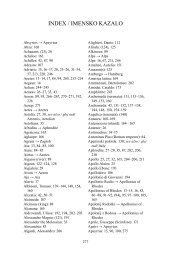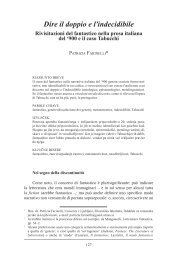The Habsburg Most Illustrious Order of the Golden Fleece: Its ...
The Habsburg Most Illustrious Order of the Golden Fleece: Its ...
The Habsburg Most Illustrious Order of the Golden Fleece: Its ...
Create successful ePaper yourself
Turn your PDF publications into a flip-book with our unique Google optimized e-Paper software.
Glen Covert<br />
that is gaining ground in policymaking: traditional or cultural value sets.<br />
Apparently, even though many Europeans do see Turkey and perhaps even<br />
Russia joining <strong>the</strong> European Union, many think that Christianity will continue<br />
to be <strong>the</strong> dominant religion. What does this projection mean? Certainly,<br />
in comparison to o<strong>the</strong>r religious cultural value sets, Christian cultural value<br />
sets are seen as remaining dominant in <strong>the</strong> EU. However, does this mean<br />
that Christian cultural value sets will continue to be relevant in regulating<br />
or guiding society, i.e. individual behavior and outlook on <strong>the</strong> world? Even if<br />
Christian cultural value sets remain dominant in Europe, do <strong>the</strong>y even stand<br />
a chance against modern forms <strong>of</strong> cultural value sets, based on law, which are<br />
<strong>the</strong> foundation <strong>of</strong> European Union, <strong>the</strong> newest dominating and very influential<br />
force in Europe? This is a question among many that I have asked some<br />
<strong>of</strong> <strong>the</strong> current <strong>Golden</strong> <strong>Fleece</strong> Knights in my attempt to glean out what <strong>the</strong><br />
medieval <strong>Order</strong> <strong>of</strong> <strong>the</strong> <strong>Golden</strong> <strong>Fleece</strong>’s purpose is today, in <strong>the</strong> 21st century.<br />
This (modern) question and <strong>the</strong> medieval <strong>Order</strong> relate to each o<strong>the</strong>r<br />
because <strong>the</strong> <strong>Order</strong> is charged by its Statutes to represent <strong>the</strong> ideals <strong>of</strong> Christian,<br />
specifically Catholic cultural value sets. Founded in 1430 by Duke Philippe<br />
<strong>the</strong> Good <strong>of</strong> Burgundy, it is <strong>the</strong> oldest and longest continuously existing<br />
monarchical <strong>Order</strong> <strong>of</strong> Knighthood on <strong>the</strong> European continent, an organization<br />
founded to promote and defend Christianity. Since its foundation, <strong>the</strong><br />
Knights <strong>of</strong> <strong>the</strong> <strong>Golden</strong> <strong>Fleece</strong> were supposed to have been and supposed to be<br />
seen as character role models for all in <strong>the</strong> Christian world, as representatives<br />
<strong>of</strong> a code <strong>of</strong> ideals that <strong>the</strong> <strong>Golden</strong> <strong>Fleece</strong> insignia symbolized. However, back<br />
in <strong>the</strong> 15th century, <strong>the</strong> Knights actually had more responsibility than being<br />
character role models, such as being a high security council. But <strong>the</strong> world<br />
has changed somewhat since 1430 including that <strong>the</strong> Sovereign <strong>of</strong> <strong>the</strong> <strong>Order</strong><br />
<strong>of</strong> <strong>the</strong> <strong>Golden</strong> <strong>Fleece</strong> is not a reigning monarch: Archduke Karl <strong>of</strong> Austria.<br />
As he is not a reigning monarch and no longer has a security council, have<br />
he and <strong>the</strong> <strong>Golden</strong> <strong>Fleece</strong> Knights also lost <strong>the</strong>ir roles as <strong>the</strong> representatives<br />
<strong>of</strong> a high Catholic ideal, as <strong>the</strong> role models for European Catholics within <strong>the</strong><br />
context <strong>of</strong> <strong>the</strong> law-based European Union?<br />
This contextualization <strong>of</strong> <strong>the</strong> world’s most prestigious <strong>Order</strong> <strong>of</strong><br />
Knighthood has only recently begun to be considered among historians <strong>of</strong><br />
<strong>the</strong> House <strong>of</strong> <strong>Habsburg</strong> and <strong>of</strong> <strong>Order</strong>s <strong>of</strong> Knighthood. Until now, <strong>the</strong> vast<br />
majority <strong>of</strong> literature dealing with <strong>the</strong> <strong>Order</strong> is concerned with its ancient<br />
medieval roots up until around <strong>the</strong> year 1950 or carefully examine <strong>the</strong> symbolism<br />
<strong>of</strong> <strong>the</strong> <strong>Order</strong>’s Treasure. Consequently, however, those works could<br />
be considered as studies on what one could call <strong>the</strong> glitter <strong>of</strong> <strong>the</strong> <strong>Order</strong>, all<br />
too <strong>of</strong>ten a distraction from <strong>the</strong> real object in question. Indeed, behind <strong>the</strong><br />
<strong>Order</strong>’s glitter are humans, <strong>the</strong> Knights, without whom <strong>the</strong> <strong>Order</strong> would<br />
fall into dormancy or extinction. Never<strong>the</strong>less, only briefly in Der österreichische<br />
Orden vom <strong>Golden</strong>en Vlies. Geschichte und Probleme (1971)<br />
did Annemarie Weber characterize its nature as an entity with an Austria-<br />
40



